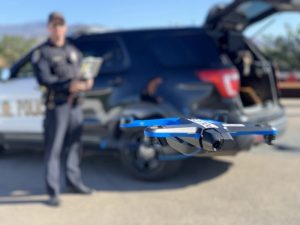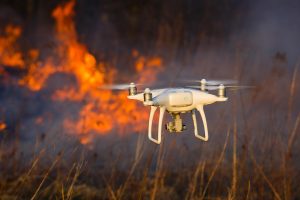
(By Fritz Reber, Skydio Head of Public Safety Integration, LinkedIn)
We are thrilled to celebrate the Chula Vista Police Department’s (CVPD) new Close Proximity, Low Altitude (CPLA) waiver to enable Beyond Visual Line of Sight (BVLOS) missions in emergency situations. This waiver is the result of months of collaboration on patrol drone operations, ground risk reduction, and policy innovation between the CVPD, the San Diego UAS Integration Pilot Program, and Skydio, and enables CVPD to fly new categories of missions to keep their community safe.
We are honored to have played a role in advancing the field of public safety drones with the help of Skydio’s revolutionary autonomy capabilities. In this blog post, I will shed some light on the process of securing the waiver, explain the new permissions, and highlight some of the ways the waiver will improve drone operations in Chula Vista and potentially your community.
The Waiver Process
Since my days as the UAS Team Commander at the Chula Vista Police Department, I’ve been aware of a dilemma that public safety drone operators commonly face — how do I do what I need to do to complete this mission without losing sight of the drone and violating FAA regulations?
Missions requiring tactical drone operations close-to-the-ground often run the risk of losing sight of the craft. Keeping the operator’s eye on the drone, however, is one of the fundamental rules for safe operation. Even the ability to utilise another person to act as Visual Observer (VO) to watch the craft for the operator is sometimes difficult or even impossible. Based upon the flight path of the mission, it may be impossible and impractical to put another person in a position where they can remain safe and still see the drone at all times. As police are often told, if you can see the suspect, the suspect can see you. So, by definition an operator who decides to use a drone to observe a suspect who is a threat to officers, will be doing this from a position where they can’t see the craft at all times.
CFR 14 Part 107.31 specifically states that a drone must be within the visual line of sight of the operator and/or VO at all times. Those flying a public aircraft under a public safety Certificate of Authorization (COA), and therefore not subject to part 107, are still required to “see and avoid other aircraft,” which by default implies the operator can see their own craft at all times. (Waivers under public safety COA’s generally provide the BVLOS capability by authorizing an exemption to CFR 14 Part 91.113(b)).
The Motivations behind the regulations are 3-fold:
- The operator has to be able to avoid other aircraft (manned and unmanned).
- The operator must be able to avoid flying over or striking people.
- The operator has to be able to avoid collisions to prevent injury and property damage.
The Skydio 2, where the CVPD was the initial public safety agency to fly it, provides 360° Obstacle Avoidance via real-time 3D mapping, object and scene recognition, and motion planning algorithms. In conjunction with limitations on altitude to avoid manned airspace, Skydio’s Autonomy Engine technology makes it easier and safer to fly close-to-the-ground and to obstacles when it’s necessary to protect the public.
In the past, these missions have been hard to fly. Every operator knows the difficulty of constantly rechecking the drone’s position to make sure it isn’t too close to a tree or about to hit a light pole. As an officer, I could not imagine a viable solution to this problem until I saw the Skydio 2 in action. Skydio’s strength is its object avoidance technology. The drone perceives the world around it and does the work for the operator to avoid hitting things. I understood the value of this immediately. It is transformative for operators who wish or need to fly in challenging environments. They fly with more confidence.
So, with the help of CVPD UAS Team Commander Vern Sallee and UAS Team Manager Lt. Don Redmond, as well as San Diego UAS IPP Program Manager Katelyn McCauley, Skydio joined forces with CVPD to form and submit an autonomy-based safety case to request Tactical BVLOS permissions from the FAA. With such a case, it was time to secure the required permissions.
We teamed up with Chief Charles Werner from DRONERESPONDERS, who referred us to Deputy Chief Christopher Sadler from York County Fire, which had secured an innovative COA for Close Proximity, Low Altitude BVLOS flights. However, York County’s COA requires a host of additional mitigations and manpower that limits its operations.
Equipped with the Skydio Autonomy system, however, we were able to push the boundaries further. We formed a detailed safety case that factored in the high value and low risk presented by operations in close proximity to the ground and nearby structures. This case also discussed the reliability of Skydio’s Obstacle Avoidance capabilities. It took many hours of meetings and documentation until the successful waiver grant date on June 25th. The rest as they say is history.
Close Proximity, Low Altitude Operations
In applying for the FAA waiver, the Chula Vista PD was required to develop a detailed safety case. Every agency will have to create their own protocols for safety cases, but here is what Chula Vista proposed in their waiver application:
: All operations to remain below the altitude of 150 feet above ground level (AGL) at all times.
: The aircraft remains within 1,000 feet laterally from the pilot.
: First Responders on the ground, trained in the basics of Visual Operations (VO), to serve as “modified VOs” to provide additional information on airspace traffic in the flight radius, to the extent required.
Operations are to be conducted using the Skydio 2 due to its object detection and avoidance capabilities. These conditions are designed to mitigate ground and air risk, and allow pilots to secure critical aerial views of evolving emergencies, without adding safety risks from the drone itself.
By remaining below 50 foot in altitude, and within 1,000 feet laterally, the pilot remains below typical manned airspace, and close enough to the drone to intervene if necessary. And due to the Skydio Autonomy features on Skydio 2, the risk of collisions with ground obstacles is greatly reduced.
Following a helpful dialogue with the FAA, CVPD received a COA that authorised “First Responder Tactical BVLOS” within the following parameters:-
: The operator must not operate any higher than 50 feet above or greater than 400 feet laterally of the nearest obstacle.
: A combination of 50 feet above an obstacle must not exceed 400 feet AGL;
: The aircraft must remain within 1,500 feet laterally from the pilot.
: There is NO requirement to use VOs, but the pilot must return to visual line of sight operations as soon as practical.
The result is a groundbreaking COA that enables new and useful operations in evolving situations. To gain situational awareness behind a wall, in a forest, or from a position of cover, pilots can now simply put up their drone, rather than having to wait for an FAA approval or set up a network of visual observers.
Although the COA does not require the use of a Skydio drone, the Skydio 2’s collision avoidance capability provides peace of mind.
One life-saving aspect of deploying drones for public safety is to gain awareness of certain situations, where it is too dangerous to send in first responders. Whilst keeping the operator safe is enhanced with the BVLOS waiver. These situations may include:-
Natural Disasters
Accessing information on ongoing fires, mudslides, earthquake damage areas, flood plains, and more without having to send first responders into danger zones.
Hostile Suspects
Operators can stay behind cover with their head down, gaining situational awareness and the opportunity to de-escalate a situation rather than direct confrontation.
Search and Rescue
In complex environments, for example, searching at low altitude to see below structures without search teams needing to traverse dangerous terrain.
These types of operations have traditionally tested the pilot’s desire to complete the mission while being compliant to FAA regulations. Resolving this constant dilemma was a major motivation for everyone working on this waiver.
Bringing CPLA Operations to Your Agency
In my view, more and more agencies will be able to secure CPLA Waivers, and while the CVPD one doesn’t make Skydio drones a must, a craft tailer-made to fly in close proximity to obstacles is of great benefit.
If you’re working toward a similar waiver or just want to talk drones feel free to reach out to me directly at fritz@skydio.com.
For more information




